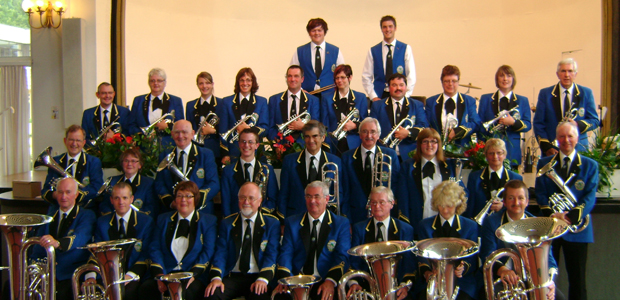Swaledale
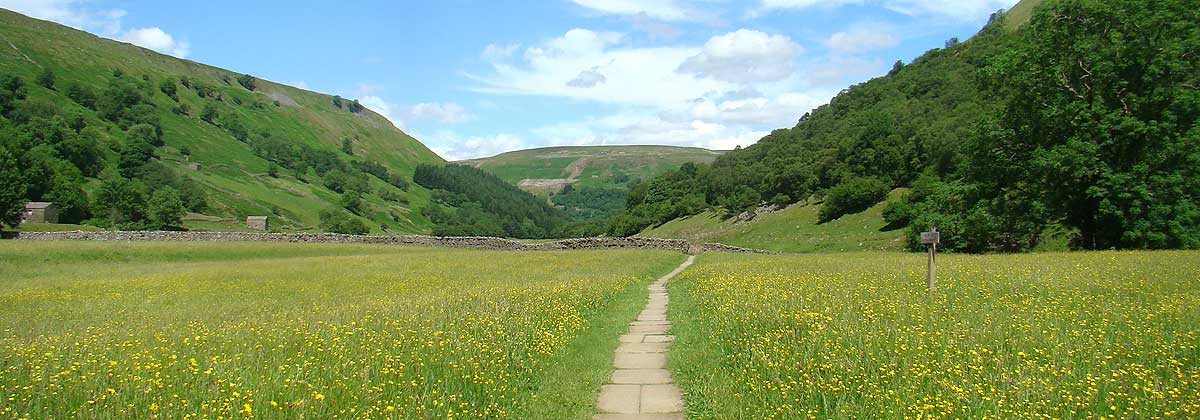
Why is Swaledale so special?
On this page:
Muker Hay Meadows and The Bluebells • Muker Silver Band • Swaledale and Farming Dialect • The Swaledale Song
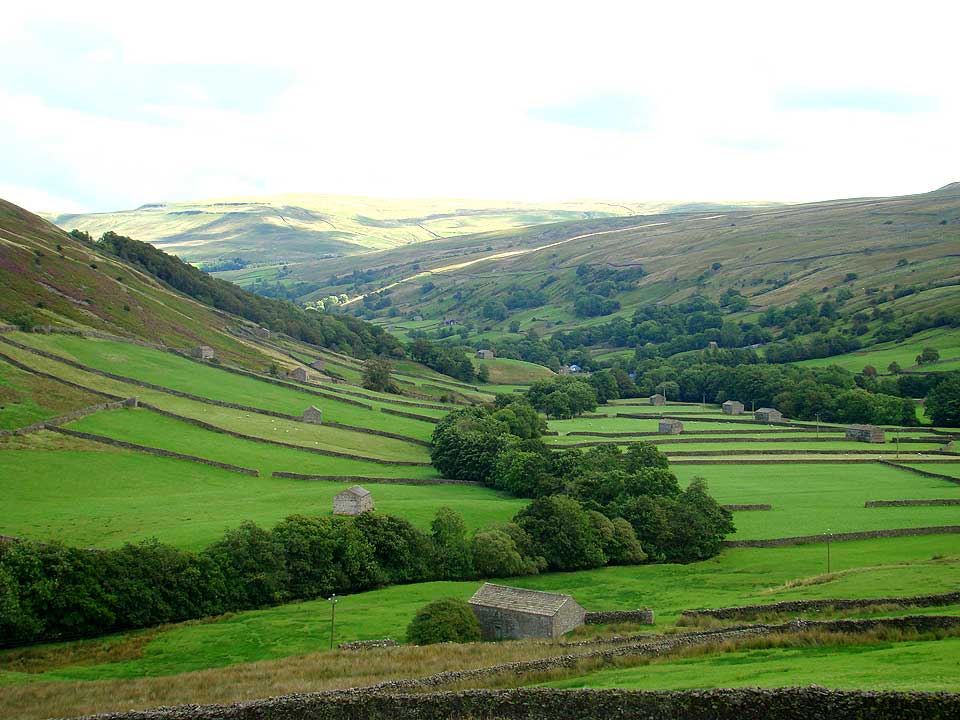
The Muker area provides one of the best places to see upland hay meadows.
The meadows are actively farmed, privately owned and some of them are protected as part of the Muker Meadows Site of Special Scientific Interest (SSSI)
and the Northern Pennine Dales Meadows Special Area of Conservation (SAC).
Coronation Meadows
There are 4 Coronation Meadows out of the 12 meadows that make up Muker Meadows SSSI in Swaledale.
A flagged footpath runs through the meadows from Muker, only 8 minutes walk from The Farmer Arms,
enabling summer visitors to experience an astounding range of colours and textures and a
quintessential aspect of the North Yorkshire Dales.
Muker Hay Meadows and The Bluebells
A lush wildflower meadow, bursting with colour and scents and alive with the gentle hum of insects is an intrinsic part of the Yorkshire Dales landscape.
Yet in the last seventy years we've seen a staggering 97% of these meadows lost, making them one of the UK’s most threatened habitats and putting hundreds of species of native wildflowers and plants, bees, birds and other wildlife at risk
Swaledale has an abundance of wildflowers; with hillsides of primroses and bluebells and hay meadows bursting with colour of several species of wildflower , it's a botanists and photographer's paradise in spring/early summer.
The Protected Hay Meadows
The hay meadows at Muker are probably the most dramatic example of flower rich fields in the country and are a bit of an unsung national treasure. Wild flowers in this concentration are a rarity in this country and are the result of years of management from the local Dales farmers who cut the fields back at the end of June (usually) to provide fodder for their livestock during the winter.
Encouraged by a number of local conservation groups such as the Yorkshire Dales National Park and specifically the Yorkshire Dales Millennium Trust who work closely with the farmers involved, these fields are becoming more and more spectacular each year.
The 12 fields at Muker offer a wide range of wild flowers which include cat’s ear, wood crane’s bill, Lady’s mantle, pignut and the lovely
melancholy thistle. Six of the fields have flagged paths, some are inaccessible but viewable whilst the first two are suitable for
wheelchairs or pushchair visitors.
"One of the most remarkable places I’ve ever visited. If ever there was a Coronation Meadow it’s this one."
- Dr Trevor Dines, Plantlife

The Bluebells
Just before the Hay Meadows spring to life and colour the dale, we are lucky enough to also have carpets of Bluebells along the River Swale, the bottom path at the side of Kisdon Hill. If you look up to your left along this route, you will see a sea of purplely blue. They are usually at their best at the beginning of May. Absolutely stunning!
Muker Silver Band
Muker Band have been making music together for over a hundred years in Muker, a village in picturesque Swaledale - one of the most northern of the famous Yorkshire Dales.
A strong sense of local identity and family loyalty has enabled the Band to survive despite Muker's tiny population. Although never a serious contestor, the band maintains a busy calendar of public appearances, and performs a wide repertoire of music both ancient and modern.
In January 1897, the Rev. James Cooke, vicar of Muker in Swaledale, chaired a public meeting in the village institute which decided to form a brass band to mark Queen Victoria's impending Diamond Jubilee. A working committee, consisting mainly of local farmers, raised £52 by public subscription to establish the band. They purchased a set of second-hand instruments, and hired the leader of the neighbouring Gunnerside band to teach the novice bandsmen to play. Four months later, the Band played it's first public performance in the village market place.
Since that time, Muker Silver Band has successfully survived the challenges of war, population movement, and social change and maintained the tradition of village music-making established a century ago. The Band, who recently celebrated their hundredth anniversary is now one of the last surviving bands in Swaledale and Wensleydale in Yorkshire. A strong sense of local identity and family loyalty has enabled the Band to survive despite Muker's tiny population. The great majority of the players (whose ages range from ten to seventy) still hail from within a few miles of the village.
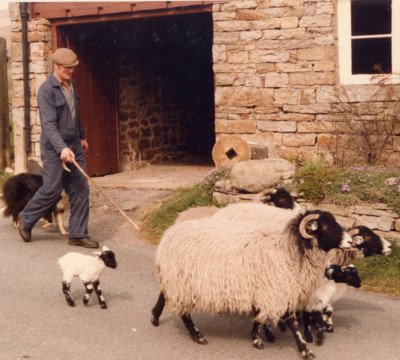
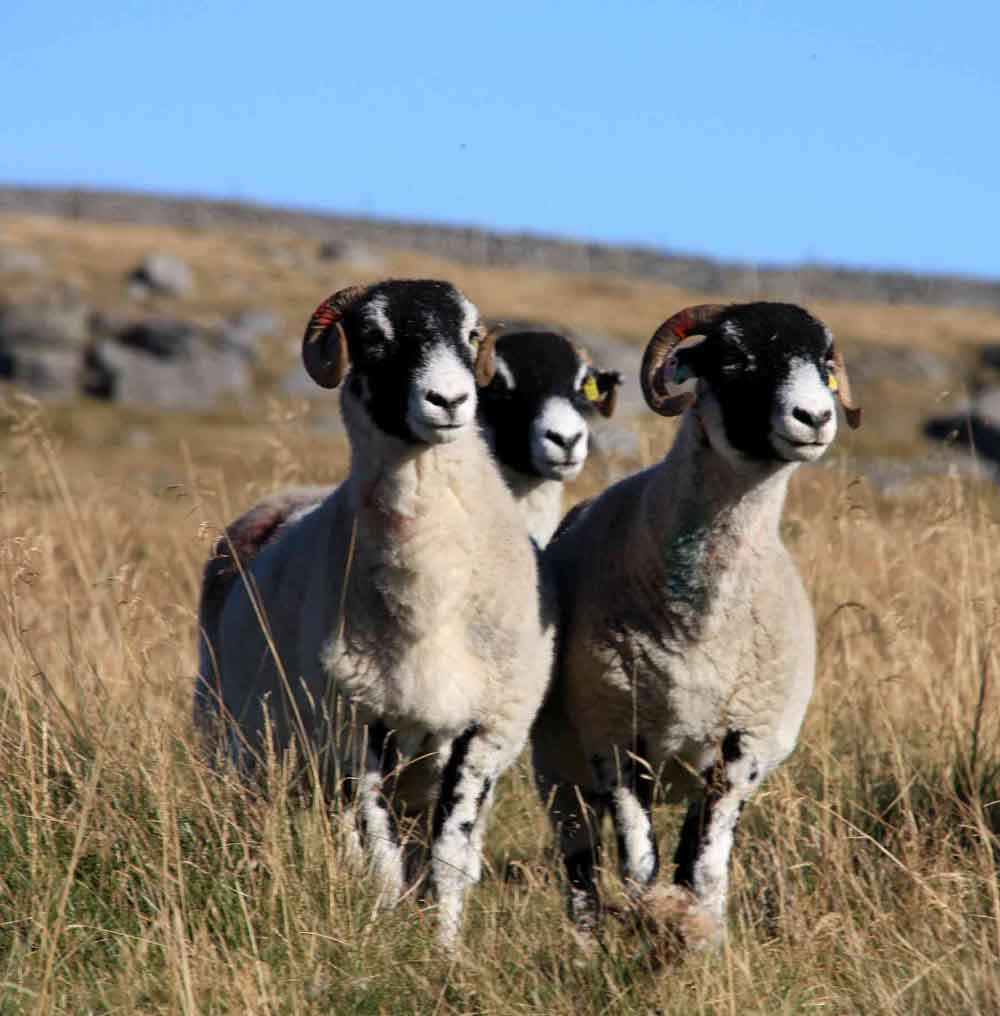

Swaledale and Farming Dialect
The Swaledale dialect (pronounced locally as Swardle) is so thick, it rivals other, better-known British accents, such as Geordie or broad Glaswegian.
It includes old English words such as "thee" and "thou" and some unorthodox pronunciations. Shoe comes out as "shorn" and laying is pronounced "lornin". Farmers will opine "It has been a gay day" if they have had a good day, while a "gay good day" is a very good day.
Unfortunately the dialect is fast disappearing due to the shifting demographics of the area. With the younger generation moving out to the towns and cities to find work and outsiders coming into the area to retire; the dialect has fast become diluted to near non-existence, but you can still hear 'Swardle' when you come to meet one or two of the true locals of the area.
Firstly, let's learn to count our Swaledale Sheep, well ten of them anyway:
1 - Yan,
2 - Tan,
3 - Tether,
4 - Mether,
5 - Pip,
6 - Azer,
7 - Sezar,
8 - Akker,
9 - Conter,
10 - Dick.
| Term | Explanation |
|---|---|
| Dam | Mum. |
| Dip | The act of immersing a sheep in a bath of liquid containing chemicals to kill parasites. |
| Ewe | A female sheep that has given birth to 2 sets of lambs (or more). Usually a sheep is 2 years old when it gives birth to its first set of lambs and 3 years old when it gives birth to its second set of lambs. So a sheep usually becomes a ewe when it is 3 years old. |
| Fleece | The coat of wool on a sheep. |
| Gimmer | A female sheep. |
| Gimmer Hogg | A young female sheep that has finished weening. |
| Gimmer Shearling | 'Gimmer' means female and 'shearling' means a two-year-old sheep. So a gimmer shearling is a two-year-old female sheep. Since sheep usually give birth to their first lambs when they are two years old they usually have their first lambs when they are gimmer shearlings. |
| Hefted/Hefting | When a sheep knows which part of the fell is its home it stays there. It is said to be hefted. There is no need to use a fence to keep them in the area. When a sheep is growing up and learning where it belongs it is said to be hefting. |
| Hogg | A young sheep that has finished weening. |
| Lamb | A young sheep that is not yet weened. This means that it is still feeding from its mother. |
| Mule | A cross-bred sheep produced for the quality of it's meat and for it's hardiness. A mule is usually a cross between a Bluefaced Leicester ram and a Swaledale. |
| Mutton | Mutton is meat from an older sheep (as opposed to meat described as lamb which is from a young sheep). |
| Pasture | A place where sheep feed on natural grass. In hill farming this can be the fells or lower lying fields which offer more protection from the weather. |
| Ram | An adult male sheep that has not been castrated. Also called a 'Tup' a ram is capable of breeding with female sheep. |
| Shearing | Removing the fleece (wool) from a sheep. Can be done with hand-operated shears or with an electric shaving device. |
| Shearling | This word is derived from the word 'shearing' which means 'clipping', the process of cutting the wool from the sheep. It describes a sheep which has been sheared once. Sheep are not sheared in their first year so a shearling really describes a two-year-old sheep. |
| Shepherd | A person who looks after the sheep on the pastures. |
| Sire | Dad. |
| Tag | A label clipped to the ear of a sheep to indicate its origin. |
| Tup/Tupped | A ram - an adult male sheep that has not been castrated and therefore capable of breeding with female sheep. Also known as a ram. |
| Tupping | The act of mating between a ram (tup) and a female sheep. |
| Whether | A castrated male sheep. |
| Yow | Another name for a ewe. |

The Swaledale Song
Beautiful Dale, Home of The Swale
A song close to our hearts and minds, sung each year at the end of Muker Show at the front of The Farmers Arms pub, as visitors and locals alike, sing their hearts out; a true feeling of community spirit.
Beautiful Dale, Home of the Swale
I will sing of a place that is dear to my heart,
A place where I always would dwell,
And if you will kindly lend me an ear
A few of its beauties I’ll tell
Chorus:- In that beautiful dale, home of the Swale,
How well do I love thee, how well do I love thee?
Beautiful dale, home of the Swale,
Beautiful, beautiful dale.
2
Oh, it’s far far away from the noise and the din
Of colliery an’ factory an’ mill,
From the bustle and stir of town life, shut in
By verdant and radiant hills.
3
And how often as boys have we wandered along
Beside of the river so clear;
The birds never failing to sing their sweet song
And lend a charm to your ear.
4
And if fate ee’er compels me to leave this dear spot
In other lands far away roam,
My earnest wish whatee’er be my lot
Is to end my days here at home.

